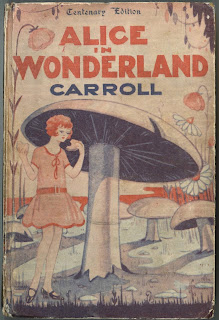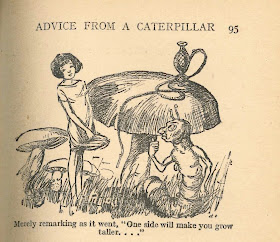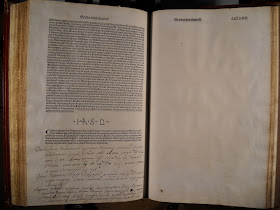 Keeping children's stories up to date is a constant challenge for publishers. In order to sell a book, especially a children's book, it needs to appeal to contemporary tastes. A new set of illustrations is a common way to freshen a story. We have dozens of editions of Lewis Carroll's Alice's Adventures in Wonderland, but this copy, which we call the Flapper Alice, is a favorite. Alice, who ought to be sporting a ponytail and wearing a pinafore over her dress, is transformed into a fashionable 1920s flapper. Her hair is even in a bob!
Keeping children's stories up to date is a constant challenge for publishers. In order to sell a book, especially a children's book, it needs to appeal to contemporary tastes. A new set of illustrations is a common way to freshen a story. We have dozens of editions of Lewis Carroll's Alice's Adventures in Wonderland, but this copy, which we call the Flapper Alice, is a favorite. Alice, who ought to be sporting a ponytail and wearing a pinafore over her dress, is transformed into a fashionable 1920s flapper. Her hair is even in a bob!The marketing of this book by The Reader's Library Publishing Company in London did not stop with Hume Henderson's new illustrations. It was part of their Juvenile Series consisting "only of books that have made good." As a result, readers were "sure of a first-rate story." Not enough? Perhaps the story would be even better with some sweets: there is a full-page advertisement for Nestle's chocolate bars on the back cover as an added enticement.
Enjoy this thoroughly modern Alice, by asking for Sine H464ali.



